Welcome to part three of our Nastiest Pitches series on the best pitches in baseball. In part one, Benjamin Haller kicked things off with MLB’s Nastiest Breaking Balls of 2022. Last week, I shifted to the hard stuff, covering MLB’s Nastiest Fastballs from last season. Today, we’ll change the pace and highlight the MLB’s Nastiest Offspeed Pitches.
Once again, Pitch Level Value (PLV), our newest metric, guided the rankings. If you are still unfamiliar with PLV, Nick Pollack’s in-depth primer will teach you all there is to know. The quick and dirty explanation is the higher the PLV, the better the pitch, regardless of what happened after it left the hurler’s hand. If you are wondering what PLA is, it puts PLV on a scale akin to ERA.
Below are the pitchers with the highest PLVs on offspeed pitches thrown in 2022 (min 100). Changeups and sinkers were considered, but as it turns out, changeups filled the entire Top 10. Thus, here are the 10 nastiest changeups from last season, ranked by PLV in descending order:
Brieske had a solid rookie season, winning three of 15 starts with a 4.19 ERA and 1.20 WHIP. He may have had some luck on his side, though, as his xERA was over 5.00, and his .242 BABIP was in the 92nd percentile. The pitch that saved him was his changeup, which ranked as the top offspeed offering in MLB last season. Below is a summary of its effectiveness:

At 82 mph, Brieske’s changeup sat 12 mph below his four-seamer, and he did a masterful job of generating strikes with it. His 68.8% Str% was in the 91st percentile, and his 43.9% Zone% was in the 85th. Batters hit only .173 off the pitch, and his xAVG of .193 suggests that wasn’t a fluke. Brieske’s change was so effective that it brought his overall PLV up above the league norm despite all his other offerings being at or below average.
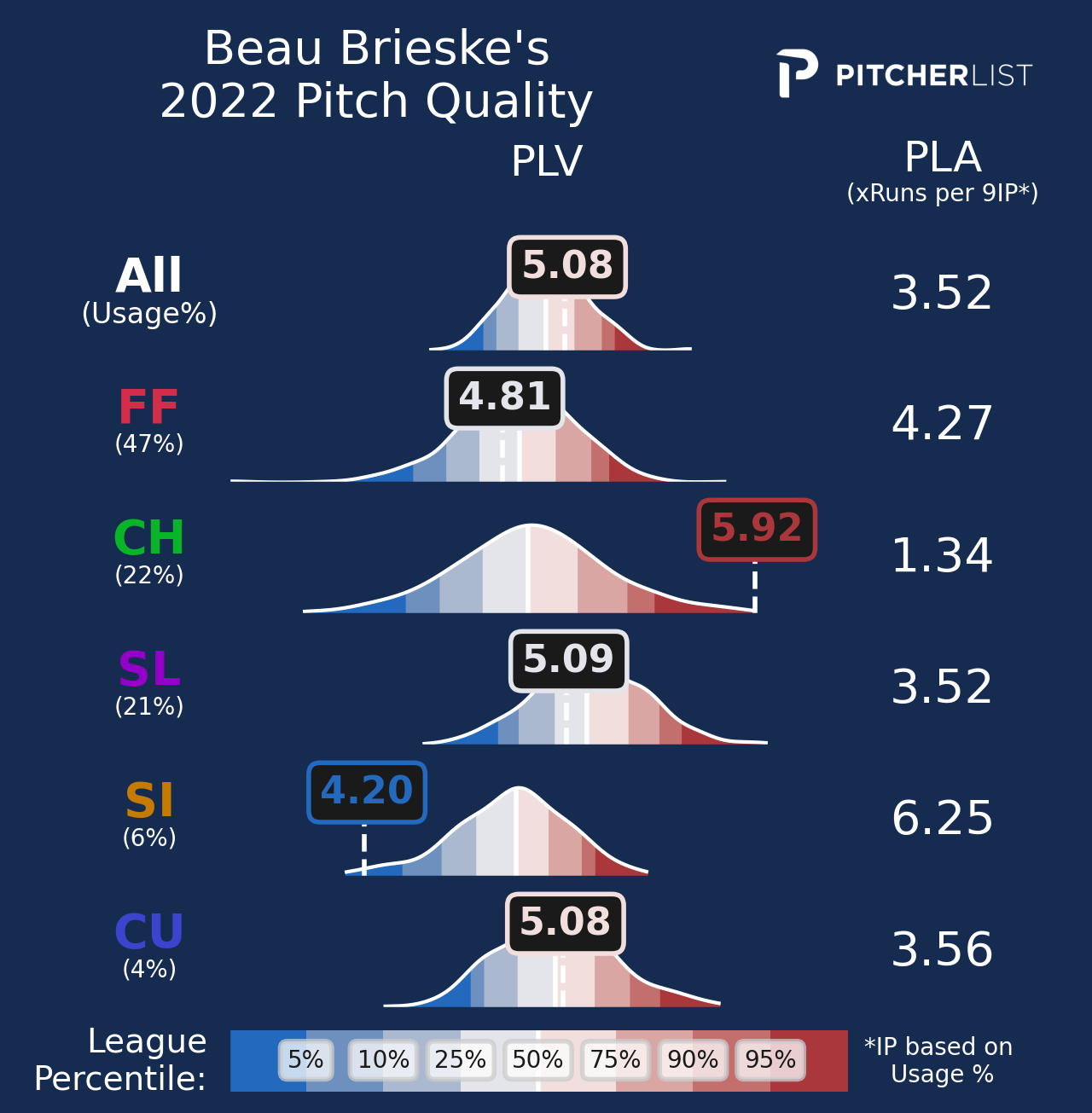
Below is the changeup in action. Brad Miller was so badly fooled that he could only wave as the pitch ran down and away from him.

Stripling had an excellent 2022 after struggling in 2020 and 2021. A 3.11 xERA and 5.13 PLV supported his 3.01 ERA, 3.11 FIP, and 1.02 WHIP. The changeup was his best weapon. Stripling induced swings out of the zone nearly 50% of the time he threw the pitch and posted a 21.7% SwStr% against it. That’s impressive! The change produced a positive outcome (Plus%) over 63% of the time for him.

Four of the five pitches Stripling threw with regularity last season were above average, as only the four-seamer ranked below. However, the change stands out, and Stripling knew it, going to it on 27% of his offerings.
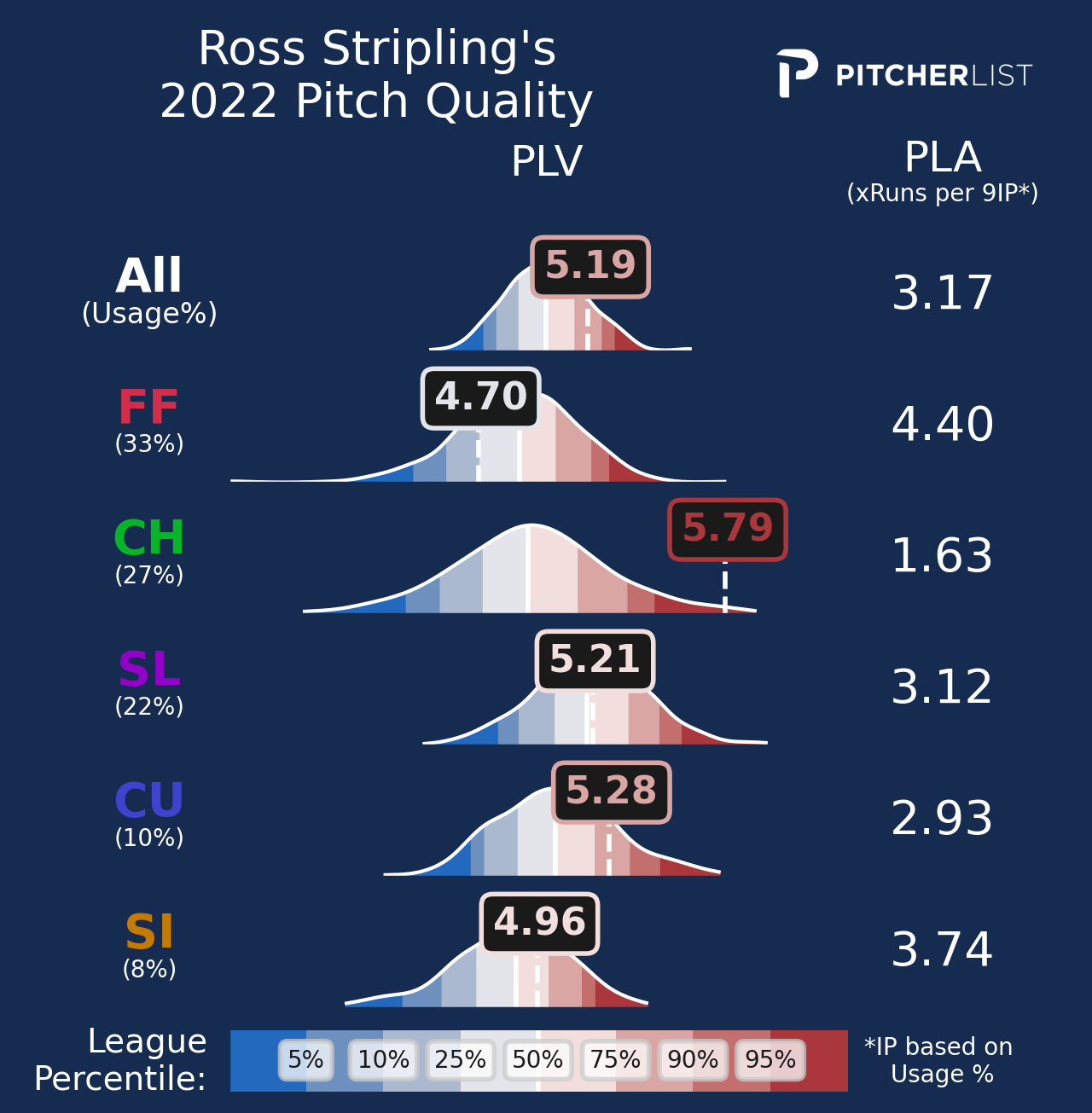
This video illustrates why Stripling’s change was so nasty. Young Riley Greene had no chance on this 81 mph pitch that ran out of the zone.

Wells stepped into a starting role for the Orioles last season and put together a solid season. Most of his five pitches worked well for him, but his changeup was exceptional. Opponents batted only .197 against the pitch, and his xAVG of .159 indicates that, if anything, he was unlucky. Wells generated strikes at a 70% clip on his change, which was in the 98th percentile. It also yielded a positive result for him over 65% of the time.

Wells employed his changeup on only 18% of his pitches, but his curveball was the only pitch in his repertoire with a below-average PLV in 2022.
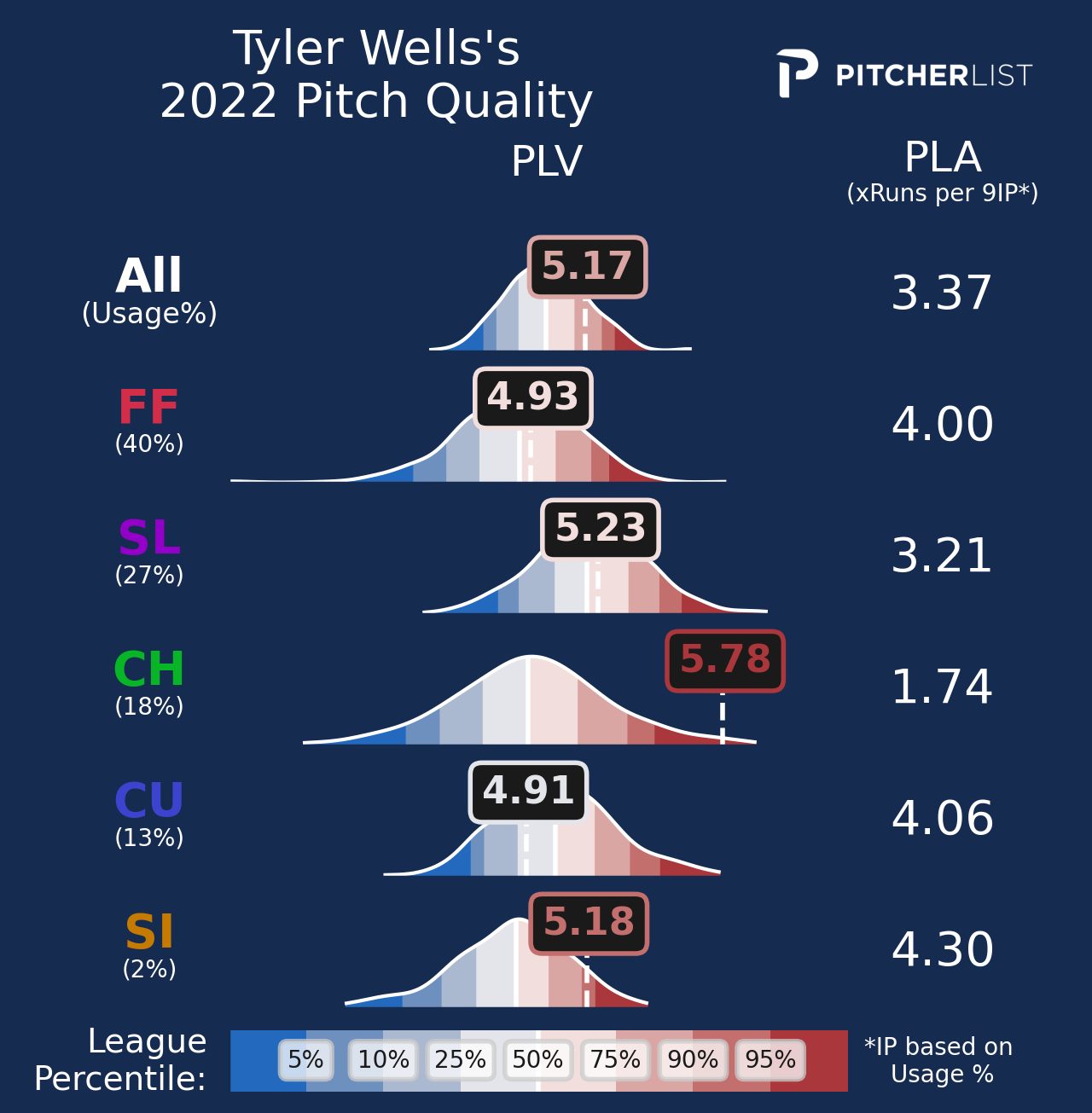
Watch this two-strike pitch to the Nationals’ Ehire Adrianza curve into the strike zone at the last instant. Now that’s what you call nasty!

Whitlock was a jack-of-all-trades for the Red Sox last year, starting nine games and saving six. His repertoire was not traditional, as he threw his four-seamer only 3% of the time. Whitlock relied on his sinker, slider, and changeup, all of which generated PLVs over 5.00. His change was the best of the bunch, though, with a PLV of 5.74 and a .113 batting average against it:

Whitlock’s sinker and change both have ample horizontal break and are 10 mph apart, as his sinker touches 95 mph. No doubt the combination kept hitters on their heels.

Travis Demeritte had no chance on this two-strike changeup that conveniently dropped out of the bottom of the zone.

Devin Williams’s changeup is his primary weapon. He throws it far more than any other pitch with great success. His changeup is so dominant that it sets up his fastball rather than vice-versa. The spin he gets on the pitch is in the 99th percentile and makes it hard for batters to square it up. A 22.2% SwStr% and 35.8% CSW% indicate how devastating the pitch was to hitters last year.

Williams is basically a two-pitch pitcher, relying almost exclusively on his change and four-seamer, which is roughly 10 mph faster. Despite his four-seamer being relatively average, according to PLV, the opposition hit only .088 against it last season. Likely, they were looking for the offspeed offering.
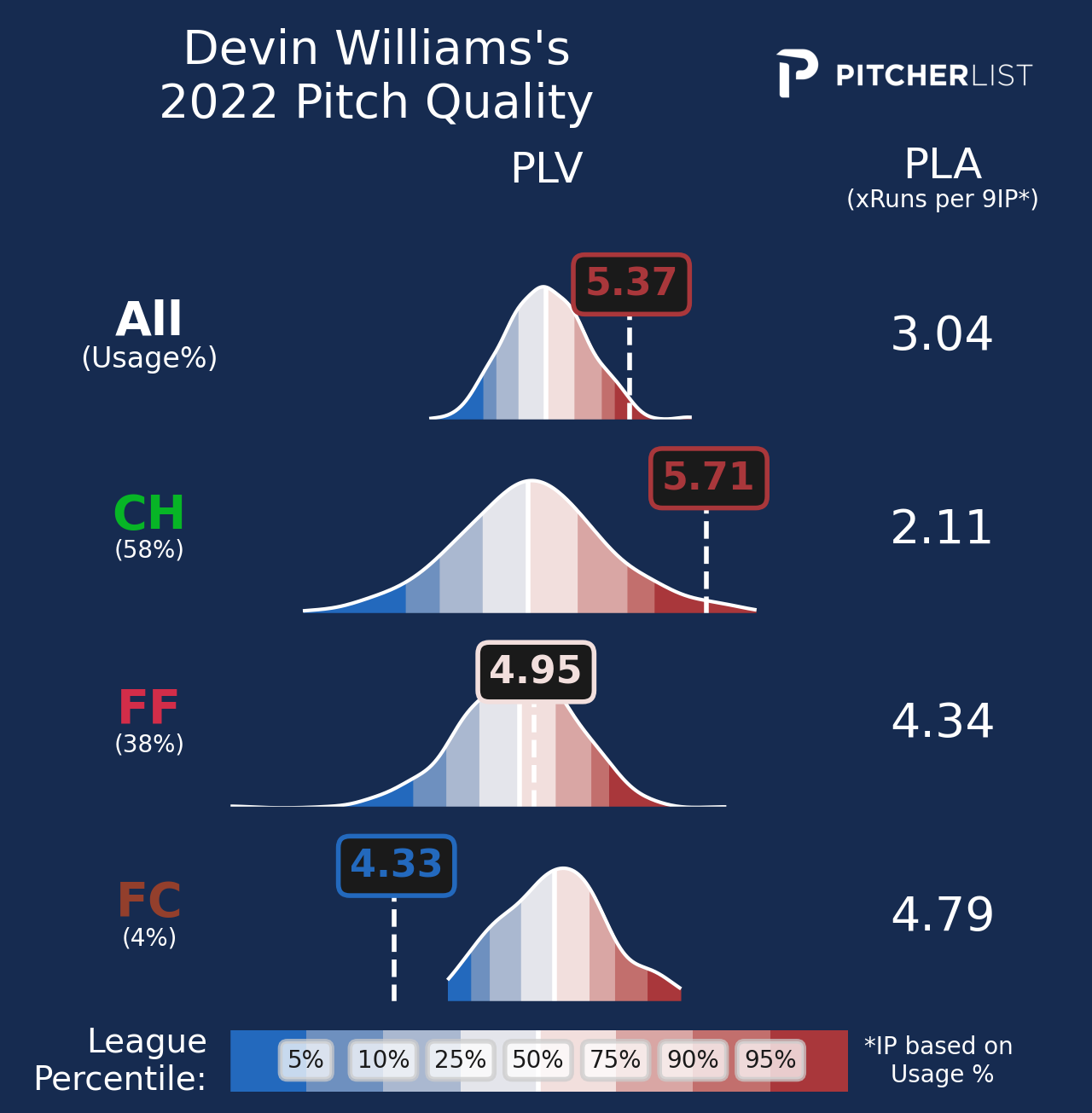
Below is an example of the changeup at work. Jonathan India tried to go get it, but the late break and drop were just too much to handle.

Chase Anderson threw only 24 innings in 2022 and posted a 6.37 ERA and a 1.33 WHIP. While his LOB% was among the worst in the league at 55.2%, his BABIP of .237 was among the best. Thus, it’s hard to call him unlucky. He appeared to deserve his poor numbers. However, one of his five pitches was excellent – his changeup. Batters only hit .125 against it and failed to make hard contact often. Anderson received positive results nearly two-thirds of the time when he employed it.

Though the change was Anderson’s most-used pitch last season, he probably didn’t use it enough, given that most of his arsenal was on the wrong end of the PLV bell curve. He may want to consider focusing on fewer pitches this year, especially if he’s working out of the ‘pen.
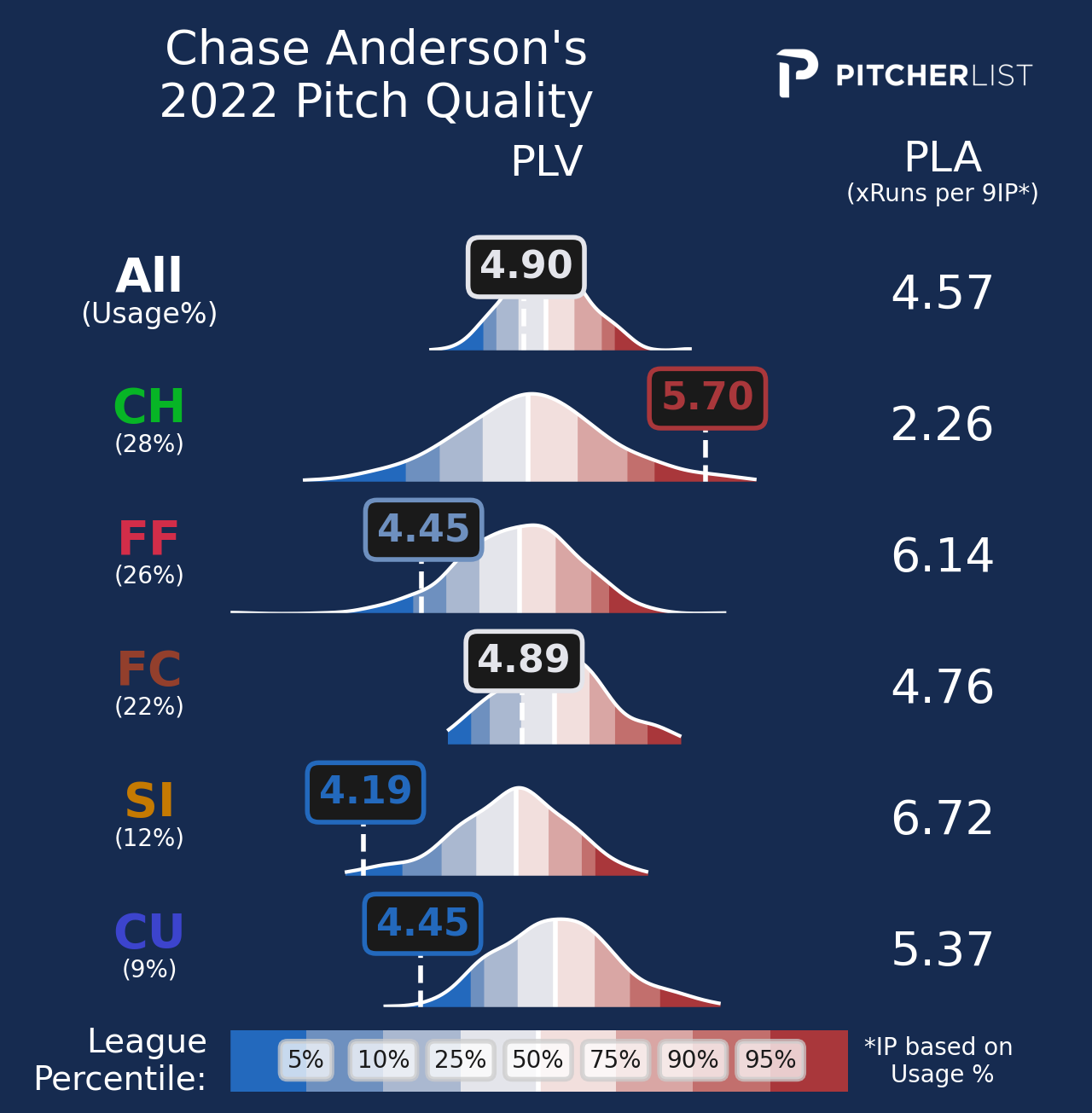
Watch how Anderson’s change moved into the zone at the last instant. Poor Rob Refsnyder can’t believe he just watched strike three.

Wacha had his best season in several years in 2022, thanks in large part to the effectiveness of his changeup. Batters swung and missed at the pitch at a high rate and hit only .168 against it. An 11.8% hard-contact rate indicates how much trouble the pitch gave the opposition.

Wacha’s overall PLV was above average, thanks to his change. Most of his other pitches were right on the midpoint, except for his sinker, which was well below average. If Wacha can keep this going in 2023, the Padres will be pleased with their offseason acquisition.
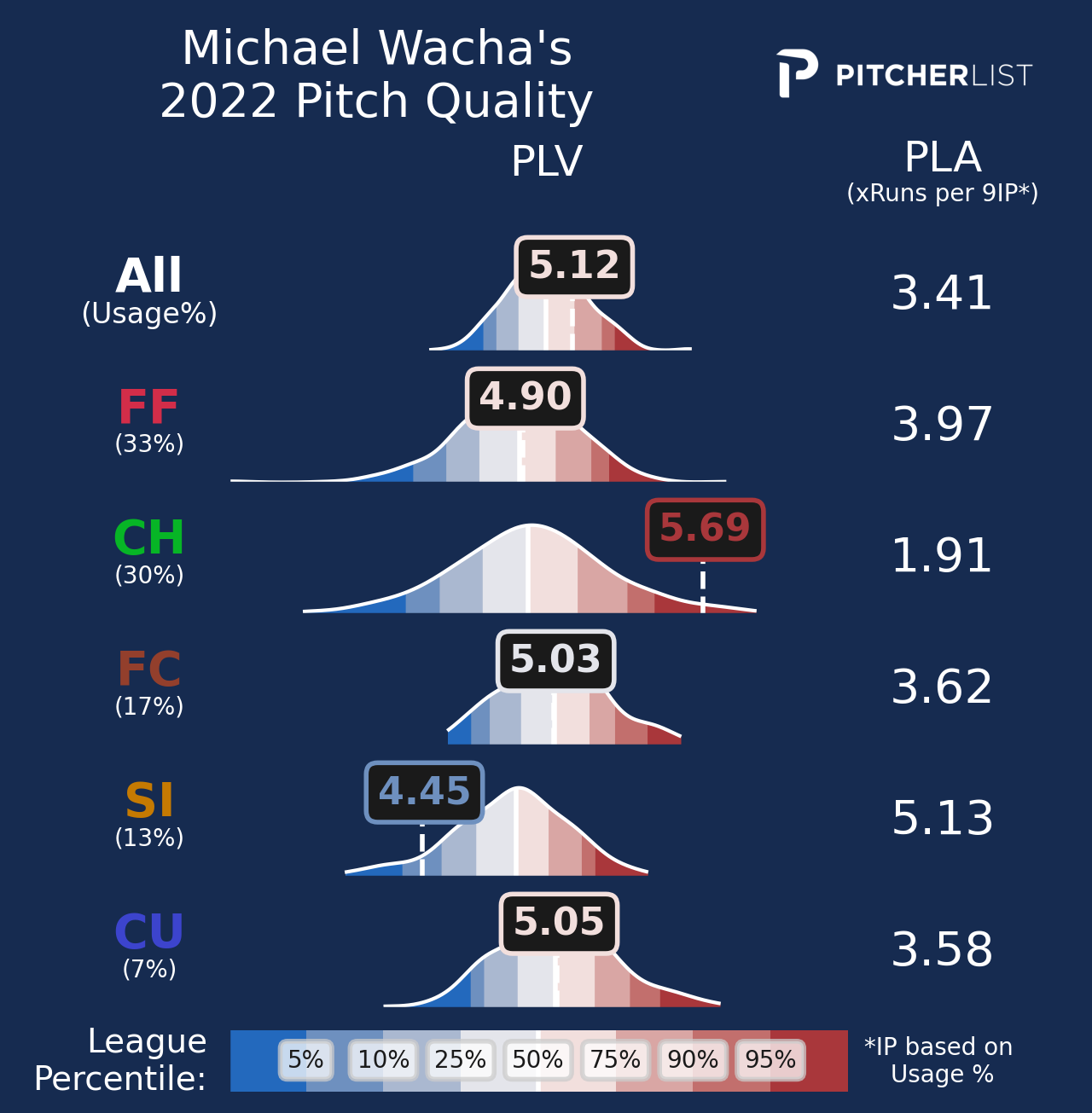
Taylor Walls thought he had a bead on this one, but no such luck as the pitch drifted away from him.

Springs was the latest reclamation project by the Rays, who turned him from a solid middle reliever to a #3 starter in 2022. He started 25 games for Tampa, winning nine with a 2.46 ERA and a 1.21 WHIP. Springs featured four pitches last season, a four-seamer, changeup, slider, and sinker, all of which posted a PLV greater than 5.0. His changeup stood out, though, as one of the top offspeed pitches in MLB. His O-Sw% was in the 99th percentile last year, and his SwStr% was in the 96th.

The lefty has excellent movement on all his pitches, with the four-seamer, sinker, and changeup breaking significantly away from right-handed hitters.
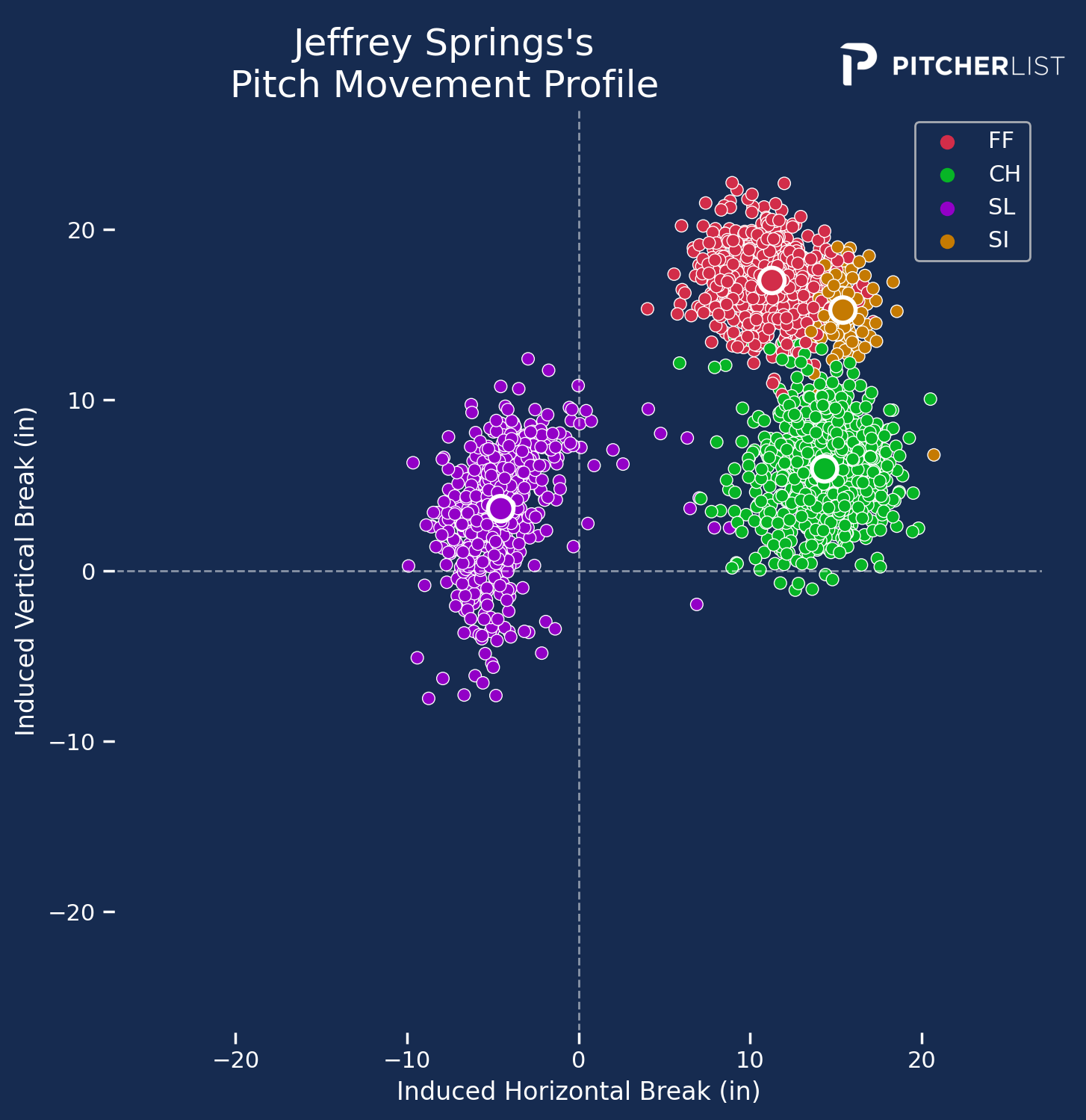
In the clip below, Springs induces the whiff from Andrew Vaughn on an 82 mph changeup away. Vaughn was miles in front of this one!

Trevor Richards’s 5.34 ERA in 2022 was not pretty; however, a 4.28 ERA and 4.07 FIP suggest he was better than his ERA indicated. Thanks to his changeup, PLV rated him as a league-average hurler. The pitch induced swings out of the zone over 50% of the time and checked in with an extremely high CSW% of 38.5%. Opponents only hit .181 against Richards’s change despite a .346 BABIP.

Without an effective changeup, Richards may have struggled as his four-seamer and curveball were well below league average.
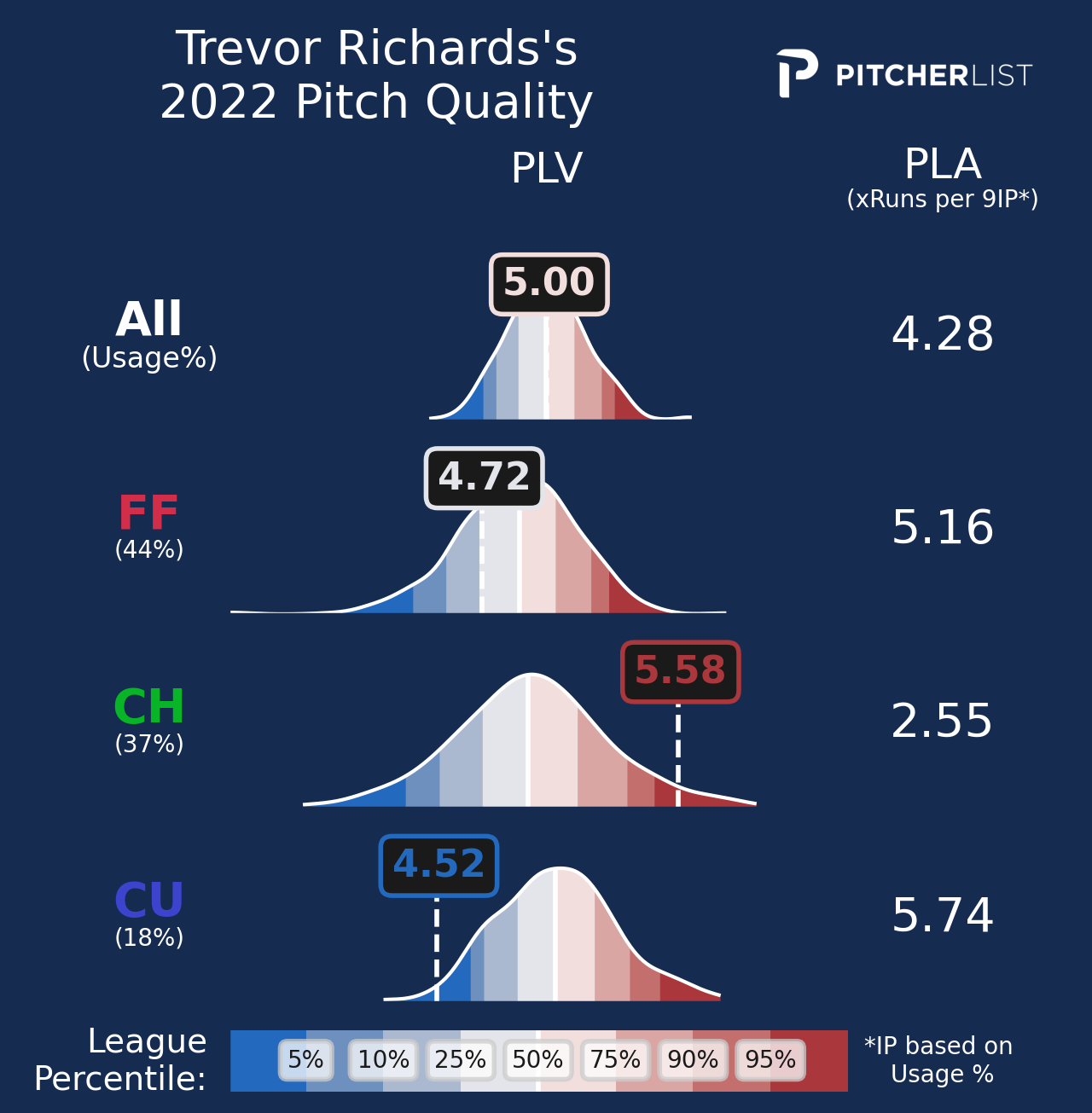
Here we see Marwin Gonzalez flailing at an 0-2 changeup, adding to Richards’s SwStr and O-Swing percentages.

Jeffries started eight games for the A’s in 2022 and lost seven. A .323 BABIP didn’t help his 5.72 ERA, but his 4.7% walk rate was probably more to blame. Despite the ugly totals, Jeffries found success with his changeup. In particular, he was adept at inducing swings out of the zone with the pitch and yielded positive results on 62% of his offerings.

Jeffries threw five pitches regularly last season, three of which hovered near the league average in PLV. His changeup offset his curveball, bringing his total repertoire to just below the norm.
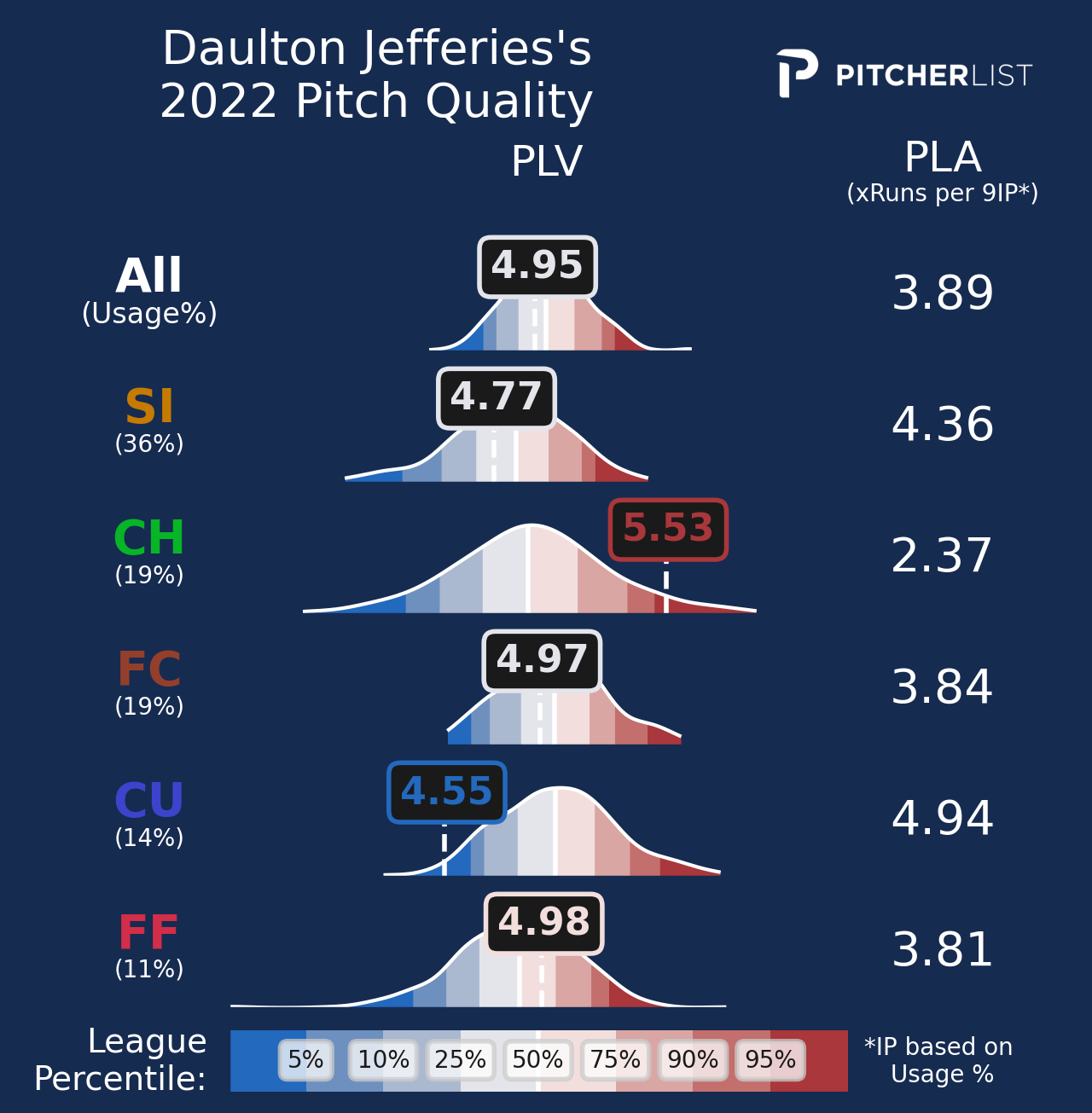
Below, Jeffries gets Jorge Polanco to chase for strike three on a changeup that broke outside of his reach.

Who else’s offspeed pitch do you think is nasty? Let us know your favorites!
Featured Image by Ethan Kaplan (@DJFreddie10 on Twitter and @EthanMKaplanImages on Instagram)


Isn’t a 4.7% walk rate good?
This list is missin Patrick Sandoval
…why does he have a PLV closer to 4 than 5 on his changeup???